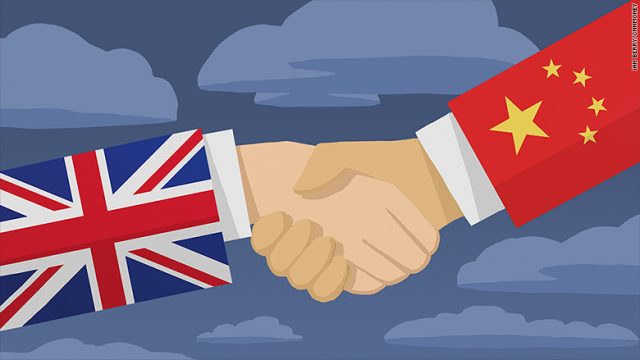
Many UK businesses are interested in importing from China to UK. For many, this may seem like a daunting task. However, with a strong understanding of the process it can be done with ease.
This guide will walk you through the steps to import from China to UK, help you define a good business model for buying from Chinese suppliers, give you an understanding of duty and tax rules, and guide you through pre-import considerations.
.
Steps to import from China to UK
Table of Contents
Thousands of British companies are earning massive and consistent profits by buying from Chinese manufacturers and importing from China to UK.
It is seemingly easy to do. Just find a product, choose a Chinese factory that can produce it cheaply, introduce it into the UK market, optimize your branding/marketing, and let the cash roll in!
However, those of you who have attempted to import products themselves will well know that doing it right seems easy but is in fact quite challenging.
There are a huge number of challenges that importers must rise above. Getting branding and marketing right, which is no small task, is just the beginning.
Here at HUACI Sourcing, we are a sourcing company that has helped hundreds of importers grow their businesses over the years. To help you scale yours, we have consolidated this information into this step-by-step guide detailing the techniques that have worked for those companies.
.
By learning from our many client’s perspectives on what works and what doesn’t, we’ve been able to refine how we coach our clients in mastering the importing from China to UK process for maximum success.

1) Select Product to Import from China to UK
While choosing the right products is important for success, it is less crucial than might be expected in building a successful brand selling Chinese manufacturer sourced products.
Nearly every product has a niche, what is more important for your business is to understand the right way to source your product.
Indeed, when choosing the right product, you must consider the market environment and your available budget. However, with sufficient capital and an appropriate strategy, you can be confident in your success.
What follows are 7 key principles for product selection that I’ve learnt through helping 100’s of businesses import product from China.
I’ve helped 100s of companies import products from China, and in the process, learned 7 key principles in selecting the right product.
Those companies that experienced success obeyed the following principles:
Tip #1: Building a brand around a product is the best thing you can do
Brands are crucial for connecting with people. Rather than simply attempting to sell a commoditized product that only competes on price, creating a brand that connects with your customers builds a long-lasting business model.
Tip #2: Stay away completely from fad products
The lifecycle of hyped/fad products is very short because the novelty fades quickly for consumers. It is impossible to build a brand around them.
Instead, as mentioned above, make the choice to focus on your long-term brand by choosing products that bring sustainable profits.
In addition, be aware that novelty products often have quality problems that are not fully resolved because they are by nature new to market. Consider hoverboards, for example. They had to be recalled because of a dangerous battery issue, hurting the brand image of companies that were selling the boards to consumers.
Tip #3: Have at least one unique selling point or differentiator
Without a point of difference (POD) that separates your product from the competition, it is hard for your product to be successful. That said, there is no need for the POD to be significant. It can be as simple as a unique color scheme, a special logo that stands out from the crowd, an excellent unboxing experience, or superior marketing photos.
To begin with, keep it simple by only focusing on one or two PODs. Once your brand begins to experience growth, you can begin implementing incremental improvements so as to separate your brand/product from your competitors.
Tip #4: Don’t neglect product safety
When you import from China to UK, stay away from dangerous products. Dealing with product liability and recalls can totally destroy your business. As mentioned above, more than 5,000,000 hoverboards sourced from Chinese manufacturers had to be recalled in the United States because of unsafe batteries, wiping out many importers.
Tip #5: Perfect must not get in the way of good
It is common for companies to try to take on too much at once at the beginning and struggle to get anywhere. I’ve seen it many times.
It is wise to have a plan for added product features, design improvements, and customizations, but it is unnecessary to have this all figured out before you make your first order from your Chinese supplier.
I suggest only sticking to a couple of products at the beginning. Do them well! As your business grows, build out your product lines.
There is no need to do everything at once.
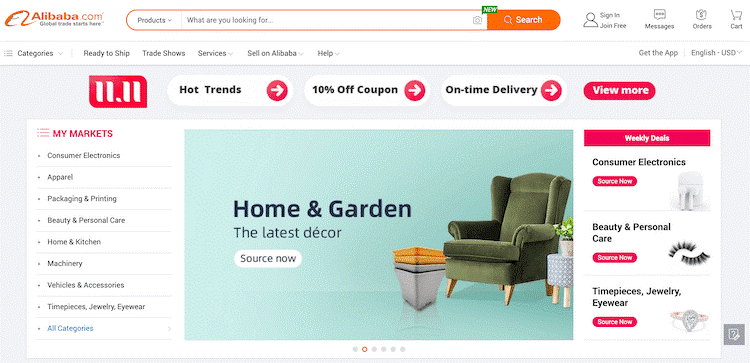
2) Find the Right Supplier
Alibaba
Alibaba.com takes the prize as the largest supplier directory in the world with an estimated 8.5 million active sellers and 279 million active buyers and is mainly set up as a B2B service.
No matter your product or niche, it is nearly certain that you will find the right manufacturer for it. Because the majority of manufacturers have a MOQ (minimum order quantity), you are forced to buy in bulk.
In terms of getting a great price this is good, but when you’re just starting out this can be a financial stretch. To find manufacturers and suppliers on Alibaba, simply search for the item with the words: ‘manufacturer’ or ‘private label’ in the search box.
.
If you take the step to become a verified buyer, you can obtain access to a more complex and detailed directory of suppliers. This gives you the capability to find experienced suppliers, see some of their most important customers, research their trade records, as well as other background information.
Although it is still possible to find trusted manufacturers without becoming a verified buyer, as a verified buyer you have greater security and information. I also recommend seeking out Gold Suppliers which Alibaba has verified.
Tradeshows
- Chinese trade shows
Not only is China the largest manufacturer in the world, but it’s also one of the most common destinations for online sellers to source their manufacturing from to import from China to UK. There are a variety of excellent trade shows to choose from if you want to travel to China to meet in person with manufacturers. Some of the largest shows are Guangzhou’s Canton Fair, Shanghai’s Import and Export Commodity Fair, and Zhejiang’s Yiwu Commodities Fair. - UK trade shows
Additionally, the UK hosts trade shows for nearly each industry. The M+A Expodatabase is an excellent resource, giving information on a current listing of nearly all the UK’s trade shows organized by product niche.
Using a sourcing company
The sign of a great sourcing company is that they can find manufacturers that you and your competitors are unable to.
A sourcing service based in China has the advantage of being able to search in Chinese, utilize local connections, and tap into their already existing supplier database.
Here at HUACI Sourcing, we discover the majority of our top suppliers through industry connections and tradeshows.
In addition, we hunt down factories the old-fashioned way, by travelling to the districts where a product is manufactured and finding producers that are not listed on Alibaba or similar sourcing company platforms.
What makes this a possible approach is that Chinese towns and cities oftentimes specialize in producing only one kind of product.
Furthermore, we narrow the search down by figuring out the raw materials for production, and the exact expertise required to make the product.
It is typical for only one or two places to exist in China where the superior Chinese manufacturers are located for producing our client’s product.
When we have found the place we want to visit, we’ll travel there and speak with Chinese manufacturers that we’ve already sourced from.
Next, we’ll seek out factories that only produce for the domestic Chinese market and ask them if they know the best factories for exporting the types of product we want to sell internationally. Factories that only produce for selling domestically don’t have a problem sharing this information because it doesn’t detract from their business.
Global Sources

Founded in 1970, Global Sources have the advantage of being in business 29 years longer than Ali Baba. Based in Hong Kong, Global Sources’ focus is primarily business-to-business. Because they were founded in America, viewing and navigating the Global Sources site has always been a more user-friendly experience for westerners than other Chinese sourcing sites.
Global Sources have facilitated over 1.5 million worldwide buyers, and 95 of the world’s most successful top 100 retailers have used their services for product sourcing.
Because bigger doesn’t always equate with better, many buyers and importers prefer Global Sources over Ali Baba. Global Sources have a reputation for high quality and careful vetting of suppliers.
Global Sources are niche-focused, so for companies in the electronics, home and gift, or fashion sector, Global Sources is often their preferred choice. Rival Chinese sourcing companies can spread themselves too thin, and many users prefer Global Sources’ specialized approach.
Conversely, some users find the lack of a rating and review system to be a barrier in finding the best products to sell. For that reason, you should weigh your options carefully before choosing to opt for Global Sources as your choice of sourcing platform.
Made In China
Unlike the other major sourcing directories in China, Made In China focuses primarily on construction and industrial products. As a result, Made In China caters to sectors like sporting goods, agriculture, automotive products, and electronics.
Some prospects will find a barrier with Made In China’s 500-piece minimum order quantity. While a buyer can ask for a few sample items, the seller may not meet the request.
Product information on Made In China is involved and in-depth. You will find accurate and comprehensive information on Chinese suppliers and their products on the Made In China website.
Made In China is particularly popular and trusted in the UK, EU, and the USA; it has a transparency that other sourcing platforms lack. Online reporting and inspection options assist in finding reliable and honest suppliers.
However, expect to pay more for products than you would on Ali Baba, for example. If price is your prime consideration, another choice of platform will better suit your needs than Made In China.
D H Gate
E-commerce specialist DH Gate has a reputation as a safe and reliable online shopping platform. Usually, their products are low priced with no MOQ. As a result, DH Gate is attractive to small and medium-sized companies, and upfront spending is generally lower.
DH Gate protects buyers in various ways.
With the seller feedback facility, prospects can check ratings before buying.
Managed Services From DHGate is a system for offering third-party payments. The third-party hold payments until product delivery. When the buyer confirms receipt of goods, payment is released.
Additionally, DH Gate mediates any disputes that occur in the buying process.
These services provide many users with a secure, safe buying experience. However, there are still questionable sellers on DH Gate. As ever, I advise you to do due diligence and tread carefully before making a buying decision.
3) Select and contact the best Chinese suppliers
It is crucial to format your initial RFQ (request for quote) and email correctly.
By paying special attention to formatting, the response rate from Chinese manufacturers is greatly increased, and the process of you evaluating and tracking Chinese suppliers is largely eased.
.
You should demonstrate in your email that you are a potential long-term customer for the factory and a professional and reliable operation that legitimately wants to import from China to UK.
- Your email should have clear calls to action and be precise
- Your email should include the correct terms for raw materials, testing requirements, and components
- Your RFQ should have an attachment with a simple product spec sheet
I typically begin by sourcing 10-15 suppliers that seem suitable. Next, I consolidate that list to the top 3-5 suppliers based first on price, then on lead times, factory size, quality (have samples sent to you), and compliance ability.
I recommend paying most of your attention to the 3-5 superior suppliers because any more than that leads to difficulty and high cost in arranging the samples and inspecting the factories.
Visiting a supplier’s factory is the single best way to verify whether a supplier is suitable.
Visiting the factory allows you to check out the equipment, determine the factory’s capacity, and examine the quality of the sample room, the factory’s own quality control systems, and the quality of the factory employees.
Additionally, it gives you direct access to the factory’s leaders to negotiate pricing face to face.
In particular, for businesses that are already established and hoping to import from China to UK, this is a crucial step and must not be skipped!
If you are unable to spend the time in travelling to the other side of the world to inspect potential Chinese suppliers, you should hire a 3rd party sourcing company to inspect your potential supplier list.

How can I verify a Chinese supplier?
In order to verify whether a Chinese supplier is the right choice for you, take the following questions into consideration:
Question #1 – Is the factory capable of producing my product? Are they experienced in this particular product area?
It is a common tendency for Chinese manufacturers to say yes to the majority of requests. Be aware of this. When asking one whether they have the capability to manufacture your product, it is rare to get a no answer!
Ask for evidence from the factory that they are capable of manufacturing your product if you have doubts.
Question #2 – Are they a manufacturing company or a trading company?
It is easy to spot trading companies. It is likely they are a trading company if they are selling a wide variety of goods across many different product categories.
If you plan to import from China to UK and would like more information on why you should avoid buying products from a trading company, read this article.
Question #3 – Are you able to effectively communicate with the Chinese manufacturer?
When importing from China to UK, if communication is something the factory is bad at, you likely do not want to have dealings with them. If something went wrong with an order, you might have to wait weeks for an explanation as to why!
Question #4 – How will the Chinese supplier’s location impact product cost and lead times?
China is a huge nation. If you purchase a product from Yichang, for example, you must consider the extra costs and time required to deliver the product to the nearest ocean port.
You must ensure that you are buying your product from the best regions.
In almost every instance, if you are purchasing electronics, you should be buying from a factory close to Shenzhen. More information on China’s manufacturing geography and the impact it has on product sourcing decisions can be found here.
Question #5 – Is the factory sufficiently large? Can they handle my order volumes?
It doesn’t make sense to purchase from China to UK from a factory incapable of managing your order volumes. Ultimately, they will probably outsource production to another, often worse, factory.
On the other hand, if your plan is to import small quantities from China to UK, don’t buy from a massive Chinese factory because you will not be important to them, and will probably have your order placed at the end of the line when a larger order comes along, leading to delays.
4) Sampling
At the very least, I recommend obtaining samples from the top two suppliers on your shortlist.
Make sure to be diligent when examining your Chinese suppliers’ samples. The majority of people don’t take sufficient care with the sample examination process.
Pay attention to the feel, look, function, dimensions, packaging, and performance of your product.
I also suggest asking more than a single person check the samples so that key details aren’t missed.
In the case that the product needs mail order packaging, ask that any sample that the factory sends to you is sent with the same mail order packaging that they will use on your order later.
Next and highly important when you import from China to UK is to conduct drop tests on your product. Ensurng that the packaging is sufficiently sturdy to handle being imported from China to UK. For more information on the right way to conduct drop tests, check out this article.
If the Chinese manufacturer is unable to match your requirements, then unless you want to make compromises, the proposed factory is basically unsuitable.
Several side points:
It is normal in China for samples to be redeveloped and redone so that they can reach your desired outcome. Be careful about writing off a factory too quickly if they don’t produce a perfect first sample.
If your company is developing a new product and samples are expensive to make, it may not make much sense to arrange for samples from 2 different suppliers. Instead, it may be best to work with the best supplier and arrange for a sample to be made with them.
5) Negotiation
Chinese suppliers are extremely good at negotiating. Make sure to come to the meeting prepared, or you can expect to overpay for your product.
Follow the 7 steps below when importing from China to UK to obtain the greatest results when negotiating with Chinese suppliers:
Tip 1. Do good research. You must be sure of your bill of materials and product specifications; you need to know where the factory is based in China and what it is like, you must obtain quotes from several different factories so as to have a measure of comparison; and you must understand how your product will be produced.
If you don’t have this information you will be incapable of effective negotiation and you will lose your credibility with the Chinese supplier.
Tip 2. Only conduct negotiations with suppliers on your shortlist. You are wasting time by making negotiations with suppliers that aren’t capable of meeting your requirements for quality.
Tip 3. You must understand your Chinese manufacturer. Will it offer you better lead times and pricing because you will be one of their first customers?
On the other hand, is it a well-established supplier with high MOQs (minimum order requirements), an extensive existing client base, and a low level of interest in your company?
Tip 4. Define a negotiation strategy according to the quality level, lead-times, and price levels you are looking for.
For example, is the price the main concern?
Or, is it also important that your factory use the components and materials that comply with a standard?
Will you pay a bit of a higher unit price if a factory has shorter production lead times?
Tip 5. Present a good business case and backstory to the factory. The days are gone when each Chinese factory is desperate for your business no matter your purchase order size.
If you are able to present a clear business case on how you want to import from China to UK, the Chinese factory will comprehend your goals and what they can do to help.
Tip 6. Conduct your negotiations with the appropriate person at the factory. For factories on the smaller and medium side of things, it’s best to negotiate with the boss as he/she will be the main decision maker and have the final say on reducing prices down below standard rates.
Tip 7. Stay strong. Use your research, and if you’re making a visit to Chinese suppliers for negotiations, don’t be persuaded by emotional triggers and expensive lunches.
Tip 8. Don’t overlook terms of payment when negotiating with your factory supplier. Typically, payment terms are a 30% deposit, and the other 70% is paid once your goods have been produced by the factory and have passed a pre-shipment inspection successfully.
What are the standard minimum order quantities?
If you’re planning to import from China to UK, you should acknowledge that each supplier has different minimum order quantities. In the section that follows, we will make note of various methods of procuring products in China and outline for you what typical minimum order quantities to expect.
.
6) Calculate your landed cost
The total cost of producing and importing your product to your distribution center/warehouse in the market you are selling in is called your landed costs, or landed pricing.
eCommerce sellers may also want to include courier costs and Amazon fees that are necessary to deliver your product to customers.
Why is it important?
You can ensure that your profit margins are sustainable and sufficient by carefully calculating your total landed cost.
It is also highly useful to know your landed costs, as they can act as a basis in negotiating prices with suppliers.
After calculating your landed costs, if they only allow for a 5% profit margin or less compared with the lowest selling price on the market, you have probably not done a good job of price negotiation and sourcing.

How to calculate your landed costs?
Although making an accurate calculation is complicated, it is a crucial step that should not be skipped when you import from China to UK! Landed costs should be based on projected order volumes for your product, rather than the MOQ (minimum order requirements) received from the product’s factory.
Be careful about basing a decision on whether a product is viable simply on a MOQ trial order, because when ordering in larger quantities (full containers), you may be able to obtain a better price.
Or course, the costs for quality control and freight when purchasing from China to UK are much lower when calculated on a per unit basis if those costs are spread out over a larger quantity of products being shipped.
Buying in large quantities also gives you greater leverage when negotiating prices.
The following information is necessary when working out your total landed costs:
- The following are necessary for getting an accurate quote from your supplier: port of loading, incoterms, product pricing and details, total cubic meters of order, overall packaging size, currency of quote, and type of shipment (less than full container load, LCL, or full container load, FCL).
- A quote that is up to date from your customs clearance agent or freight forwarder that has: local charges at the country of import, freight costs from port of loading to port of discharge, trucking costs, local taxes, and local duty rates.
- Your actual exchange rate and currency costs. These are different than the trading price.
As I walk you through the landed quote formula and examples, I’ll assume for simplicity’s sake that you are using the FOB incoterm when purchasing from your factory supplier.
Most importers from China to UK use the FOB incoterm. If you would like to learn more about incoterms and why they are important to understand, click this link here.
7) Purchasing
There is a right way and a wrong way to do it when purchasing a product from China to UK. First of all, make sure you get a purchase contract in place. To do this correctly, your purchase contact must contain the following:
- Amounts
- Late fines
- Payment terms
- Agreed tolerances
- Clear payment terms
- Agreed standards on quality
- Product specification including packaging, product, and instructions
A clear purchase agreement must be in place for any product imported from China to UK. It is essential. Don’t just discuss the above details, get them written up in an explicit agreement.
If you choose to work through a buying office, it is standard for them to create and manage the purchase agreement.

.
8) Payment Options
Payment options can be negotiated, and they can vary in different circumstances. Most businesses that import products from China work based on the importer paying a deposit, and then later paying their balance shown on the bill of lading (once the Chinese supplier has shipped the goods from China to UK).
I’ve included some examples of payment terms from ‘worst case’ for you to ‘best case’.
100% payment prior to production beginning
This carries an extremely high risk because the importer lacks any leverage over the factory they are dealing with once the money has been paid. In general, this payment term would only be used if the placed order is minimal, which would be less than £3800, for example.
30% deposit then 70% prior to shipment
In this case, the importer first pays a 30% deposit to the manufacturer on the order. Once the goods are produced, the importer pays the remaining 70%. The goods can then be shipped. This is not the best scenario from either a cash-flow or risk perspective for the importer. If the Chinese manufacturer wanted these terms in the deal for any order greater than £7,600, it should be a warning sign that the manufacturer has a reason for offering such poor terms to the importer.
30% deposit, 70% against bill of lading
Any importer should expect these terms as standard for to import from China to UK. The importer pays a 30% deposit to the manufacturer, enabling the importer to have strong control over the quality of the goods being manufactured. Once the goods are shipped out of China and in a container on the way to them, the importer can pay the remaining 70% of the balance against the bill of lading. This strategy also enables importers to better manage their cashflow.
0% deposit, 100% against bill of lading
These are great payment terms for the importer. There is no required deposit, and the Chinese supplier agrees to manufacture the product according to the importer’s purchase order. Only once the goods have been shipped out of China and are on their way to the importer must the payment be made. These payment terms are generally only achievable if you’re working through a sourcing service, such as HUACI Sourcing.
0% deposit 100% balance after 90 days (ordering goods on credit)
These are basically the best payment terms you can achieve for doing an import from China to UK. Getting credit terms from the Chinese manufacturer requires meeting specific criteria, such as contract history, credit checks, and trading history. These terms can basically only be earned through operating through a dedicated buying office like HUACI Sourcing.
9) Quality Control
All purchases when you import goods from China to UK should have a quality control assessment. No matter the size of the Chinese manufacturer, it is wise to have good standards in place, as factories almost always have some degree of quality issues from time to time. These could vary a lot depending on the factory.
It is worth observing that no matter the amount of quality control, you cannot turn a bad Chinese manufacturer into a good one!
As an importer, whether you are importing a single container load of products or massive amount, the effect on your business can be severe if you miss a quality issue on any batch.
Once your goods have been imported from China to UK, they cannot be returned. Therefore, you the importer must either sell the stock as a second-hand product, apply some damage control means, or fix the mistakes/issues.
You could try to sort out highly defective and unsellable stock from that which is still sellable or make the decision to dispose of the stock because it cannot be sold as it would damage your brand. It is a tough decision that you hope you never have to make!
To avoid getting in that situation, each batch of the product should be quality checked! The following are various forms of quality control:
- Pre-shipment inspection – this is an inspection of the batch once production has finished.
- Online inspection – a Quality Inspector visits the factory every single day during the production process.
- Container load check – this method ensures that the shipping container is loaded correctly, and the right quantity of product is loaded. With fragile items such as glass this is especially crucial.
- Mid production inspection – making checks during the middle of production to make sure that the right colors/materials, etc., are used.
The simple rule of thumb is that the more quality control you do, the less risk you will have! That said, you must find a balance between the amount of quality control you practice and the cost of conducting that quality control.
Working through a sourcing service, such as HUACI Sourcing, will give you a built-in quality control team that is already in place. They will assess each SKU (item) as well as assessing each manufacturer and put in place the right quality control plan for you. HUACI Sourcing exports over 20 million USD worth of goods for businesses importing from China to UK.
In addition, the Quality Control team will help you create, control, and implement the plan. For example, if you are doing business with a new Chinese supplier, the first order will require a much higher level of inspection compared with a well-known Chinese manufacturer that has been in business for a while.
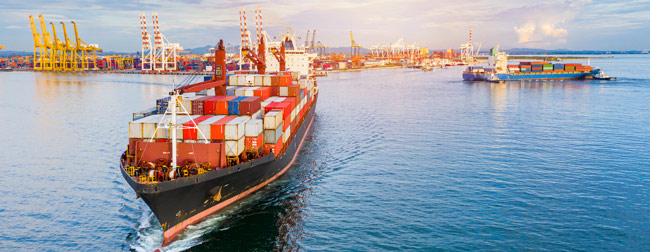
10) Shipment
When you import from China to UK, the ideal way to ship these is ‘by the container load.’ Your product will be loaded into a container unless shipped by airfreight.
You can either import a ‘Less than a Container Load’ known as ‘LCL’ or a ‘Full Container Load’ known as ‘FCL’.
LCL (less than a container load) shipments
LCL shipments may be the only option of you have a small order or even a sample order. When your goods travel from the Chinese manufacturer to the port, they will be loaded into a ‘shared container’. When they arrive in your country, they will need to be unpacked from the container at the port so that your products can be delivered to you. This means that your products will be handled by a number of people before they are delivered, and those people may not treat your products with much care.
Because of this reality, LCL shipments are notorious for being damaged. If you are going to ship in this way, it is essential to ensure that your manufacturer has packed the product exceptionally well, something a sourcing agent can help with.
FCL (full container loads) shipments
If you order a full container load from a Chinese manufacturer, the actual container will be delivered to the factory, which will then load your goods into the container.
Once the container is all loaded and the doors closed, a seal is then put on the container. Only once the container arrives to the importer will the seal be broken. This means that no one else has handled the goods!
The chance of damage when the goods arrive with the importer is very little as long as the container has been correctly and carefully loaded.
At HUACI Sourcing we recommend and offer Container Loading Inspections for all importers. This ensures:
- That as the container is being loaded, the laborers do so with utmost care.
- That the correct quantity is recorded/loaded.
- That cartons are stacked the right way, ensuring that as they load products on the top part of the container, they are not damaging other units of product by treading on boxes at the bottom of the container.
Best size of container to import from China to UK
In general, no matter what country you are in, you should always use standard sized containers, 20ft, 40ft, 40ft HQ (High Cube).
Larger containers equal lower cost per cubic meter, meaning your ultimate price on the imported product will be cheapest if you use a 40ft container.
The reason for this lower cost is that the majority of ports around the world charge the same or a very similar amount of money to handle either a 20ft or a 40ft container.
Because the total cubic meter volume is more than double in a 40ft HQ container vs a 20ft container, the ocean freight per cubic meter is less than half in a 40ft container compared with a 20ft container.
The haulage/trucking cost must also be factored in. Because there is a similar trucking charge for a 40ft HQ container compared with a normal 40ft container, there is more value and overall lower cost per cubic meter by going with a 40ft HQ container.
The majority of companies that import from China to UK choose to use a combination of a freight forwarding company and their procurement office to handle the shipment/logistics of their products.
The product procurement office handles everything until it is out of China; they will then provide both you, the UK importer, and the freight forwarding company you are using in the UK with all relevant documentation to import the product. These documents include a bill of lading, commercial invoice, packing list, etc.
The freight forwarder will then confirm and arrange both the customs clearance and co-ordinate delivery with you, the importer, once the container has arrived at your local port in the UK.
I want to reassure you that although the import-export process may seem daunting, this is typically an easy part of the whole process.
Shipping time from China to UK
It is important to know how long it will take to ship products you are importing from China to the UK. Transit time is impacted by shipment size, season, and location. The following table shows estimates on timing for each shipping mode from China to UK.

Cost to Ship LCL Container from China to UK
The delivery location and the shipping term you agree with your supplier will determine the cost to import a 40ft container from China. An estimate for your total cost if you’re still in the planning stage is £2500-3000 + UK Duty & VAT although this will fluctuate. The cost should not be too much more than this and could be lower.
Cost to Ship FCL from China to UK
The shipping cost for a 20ft container imported from China to the UK will vary based on the agreed upon shipping terms with the producer and your exact delivery location. A good estimate for buying on FOB shipping terms is £1800-2000 + UK Duty & VAT, although this will fluctuate. The cost could even potentially be lower.
.
Business Models for Importing from China to UK
Once you have made the decision to become an importer from China to the UK, the next step is to decide upon a business model for importing. Your business could make use of a buying office or agent or decide to import the product directly from China.
Importing Direct
Many people assume that direct importing from manufacturers is superior because you will cut out unnecessary costs and get the best price.
By using this model, you can talk with the Chinese factory directly (technicians, sales, and decision makers). I believe this is half true and half wrong. These days, there are many resources available that one can easily make use of and apply to your importing business. Of course, this approach costs you time, and time is money.
Although you may theoretically get the best price per unit on your goods when importing directly, you should also realize that operating through a China-based sourcing company will help quite a bit in growing your business faster.
They will enable rapid growth by taking away headaches you must deal with surrounding your product.
Pros of direct importing from China to UK
- You have full control of the import process.
- Good prices in most cases.
- You have access to your manufacturers, and you will work directly with them.
Cons of direct importing from China to UK
- Most manufacturers require a high MOQ to manufacture your product. For factories to be competitive, they normally run production in a low profit big volume scenario. Additionally, the quality of parts, raw materials, and packages also play a big role.
- Most factories are oriented towards production and overlook other services they should offer. Few factories have a good knowledge of how to fully meet and solve customers’ needs and pain points.
- Some of the factories might not have an actual export license or real experience.
- You must invest a large amount of effort and time to deal with the whole import process and supply chain management and issues that might occur.
- Your import process can be slow due to the language barrier, time difference, culture difference, communication efficiency etc.
Sourcing company in China
Sourcing companies are also known as sourcing agencies or sourcing services. An excellent sourcing company can integrate supplier resources with greater efficiency and serve a number of different buyers at the same time. These kinds of companies are made up of different organized units like quality inspecting, sourcing, warehousing, and shipping systems.
Most sourcing companies have the capability to deal with everything from delivering the final goods at your warehouse to selecting the right Chinese supplier for you.
The sourcing company you are working with will also represent you at the factory by monitoring the mass production if necessary. Having a sourcing agent in China is much more convenient than having to fly all the way to your factory to check on them now and then.
The sign of a great sourcing company is that they provide transparency in terms of how suppliers candidates are selected. They can help you get a good idea of whether your potential supplier will perform well, will perform at a mediocre level, or will be horrible for you.
HUACI Sourcing is a UK-owned sourcing company with more than 15 years of experience dealing with British importers. The company is based in Shanghai (China) and exports over 20 USD million worth of goods per year. Click on the button below to find out more about our sourcing services.
Pros of using a sourcing company to import from China to UK
- You will get efficient and fast results and quick turnaround.
- You will have the supply chain management under full control by having professionals managing the entire import process.
- Professional sourcing agents are able to negotiate lower prices with factories than you may be able to.
- You will be able to devote your valuable time to operations, marketing etc.
- Value-added service like free package design, building a website, latest marketing information etc.
- The sourcing company is always a good helper for quality control.
Cons of using a sourcing company to import from China to UK
- They might be getting kickbacks from the factory that hurt your bottom line.
- May have less expertise than the actual Chinese manufacturers in specific product categories.
- It may still be challenging to find a truly satisfactory Chinese suppliers.
Chinese Sourcing agent
They can be hired as a full-time agent for you, and usually work at a small office or home office.
Individual sourcing agents can commonly be found on freelancing platforms (like Upwork, fiverr, etc.), and some of them have even set up their own websites that can be found with a Google search. Some agents may have some experience working in a sourcing or trading company.
In reality, a sourcing agent does not have much of a reputation to uphold. When you think about it, there really isn’t a duty of care. In general, there also isn’t much accountability.
The sourcing agent is in another country, so you can’t just arrive on their doorstep and tell them they didn’t work hard enough, and that they picked the wrong Chinese manufacturer for you. There is no easy way to get a refund, either.
It is common for sourcing agents to simply get quotes from a Chinese manufacturer that they’ve worked with in the past for another client who wanted a similar product. They don’t typically do an organic search for a good manufacturer or consider what is important to you, the customer, in a factory.
If you get stuck with the wrong supplier, it is a ticking time-bomb. You’ll likely overpay, and there’ll be communication issues, consistency issues, quantity issues, supply issues, and quality issues. Worse case scenario, they could completely stop replying to you or get shut down by the government (which happens
Tax and Duties when Importing from China to UK
You have to pay taxes and duties to UK Customs when buying goods from China to UK. These must be paid before your goods can be released into the UK.
In order for you to have a strong understanding of everything regarding Customs and what might cause your goods to be held up at the border – which costs you extra money! – The two main costs you should understand before importing from China are UK Duty and VAT.
What is the Import tax from China to UK (VAT)?
Shipping quotes often include the phrase: “plus UK duty & VAT”. Don’t make the mistake of thinking that the VAT is calculated on shipping price; it’s really the VAT on the taxable import;
- You are effectively paying VAT on everything that it costs for you to buy the goods and circulate them within the UK.
- The taxable import on which VAT must be payed is the amount that you pay for your goods, plus the shipping cost, plus the UK Duty.
- If you buy goods from China, you won’t pay VAT to the supplier, but that doesn’t mean you won’t have to pay it at all.
How to avoid import tax from China to UK?
This is a question that often gets asked. The first thing that we must stress is this: avoiding paying tax is illegal! It’s fraud, and if caught, the penalty could be a large fine, or even jail time!
As such, the question that we would advise you ask is this: Do you really want to be in a business that cannot sustain itself by achieving its target margins if you have to resort to fraud and face such serious risks?
Furthermore, in the UK, when you import there are two types of tax: VAT, and duty tax.
Many products can enter the UK duty free. Or even if there is a duty to pay, this is generally a very small % of the total product landed cost.
As such, VAT is the largest tax, and this works differently for companies & individuals that are VAT registers or not.
If your turnover is under 84,000 GBP, then you don’t need to be VAT registered. This means when you sell products, you don’t need to add VAT onto the sales price.
However, as soon as your business turnover is more than 84,000 GBP, you must become VAT registered.
This means that then the VAT you paid on the import goods you will get back, however, you do have to charge VAT on your sales price.
As such, generally anyone asking this question is a) trying to make profit by fraud, which we don’t condone, or b) simply doesn’t understand the tax system, and why as a VAT registered business there is zero/no gain in trying to avoid tax on imports.
Finally, there is one other genuine way this question is asked. It is the question of whether a product has had a design/mould/tooling fee incorporated into the product cost.
For example, if a factory had a large design costs to design your product but never separated out the cost of the design, and the unit cost of the product, then this is something that you can look into in order to adjust the unit cost of the goods.
All of these cases should be looked at on a case by case basis and where these is any ambiguity you should contact HMRC for clarification.
Imports Duty on Goods from China to the UK
The type of product that you are importing, and the declared value of the goods determines the amount of UK Duty that you must pay. The UK government gives each product a different duty rating/percentage.
In order to figure out how much you will have to pay for your product, you can either contact us and we’ll find the most appropriate heading for your goods or you can make use of the online lookup at www.gov.uk/trade-tariff .
How to pay Duty and VAT?
If you’re not sure how to pay the VAT and Duty you owe to HM Revenue and Customs for your import, it is easy to figure out. Whatever method you choose to use to import from China to UK, the company doing the customs clearance will likely contact you in order to confirm how much you owe and how to make the payment.
When importing with HUACI Sourcing, we’ll make the goods declaration to customs and pay the UK VAT and Duty on your behalf to have your consignment released from customs. We will take the exact UK VAT and Duty figures and include them to your freight invoice.
Then, before delivery, you can simply pay the Duty and Import VAT along with the shipping in one fell swoop! We include this as part of our service (most sourcing services charge an extra fee for this).
It is a similar process for importing smaller consignments or samples via a courier company or the postal service. Because you’ve likely already paid the shipping cost on the front end, you just have the VAT and the Duty to pay. Whatever company you go with, be it Parcelforce, Royal Mail, FedEx etc., will inform you on the cost of the VAT or Import Duty you owe for your shipment. Normally, they’ll return the goods to the sender if you don’t pay the costs within three weeks.
Are there Duty and tax charges on samples?
This question lacks a definitive answer because it is dependent on several different factors. Normally, there are duties when importing from India, China, Taiwan, and the USA. On occasion, VAT and Duty relief is granted. VAT and Duty relief can be given on a product sample if:
- Are intended for gaining orders for the commercial product represented (i.e. are not truly functional)
- Are negligible in value (below £39 for gifts or below £15 for businesses)
- Once imported they are only used as sample products
At the time of writing, goods with a commercial value (duty + shipping cost + insurance + goods value) greater than £15 are liable to VAT, although customs may change this figure. Additionally, the UK has a higher threshold in place for goods with a commercial value that is greater than £135. HMRC’s site includes the exact figures, found here.
.
Pre-import Considerations
When importing from China to UK, it is crucial to have a clear picture of what your pre-import considerations should be. Whether you are using a sourcing agent or going about the process of purchasing product from a Chinese factory yourself, you must understand steps including documentation and quality compliance standards when importing from China to UK. If you have a great plan in place of what it takes to get the job done right, you are well on your way to success.
Documentation
Commercial Invoice
This important document gives a description of the products, verifies the sale, and reflects the consignment price. Customs valuation has its basis on the commercial invoice’s value. Customs will raise the alarm if there is any discrepancy between the rates charged in the commercial invoice and the normal value for the goods.
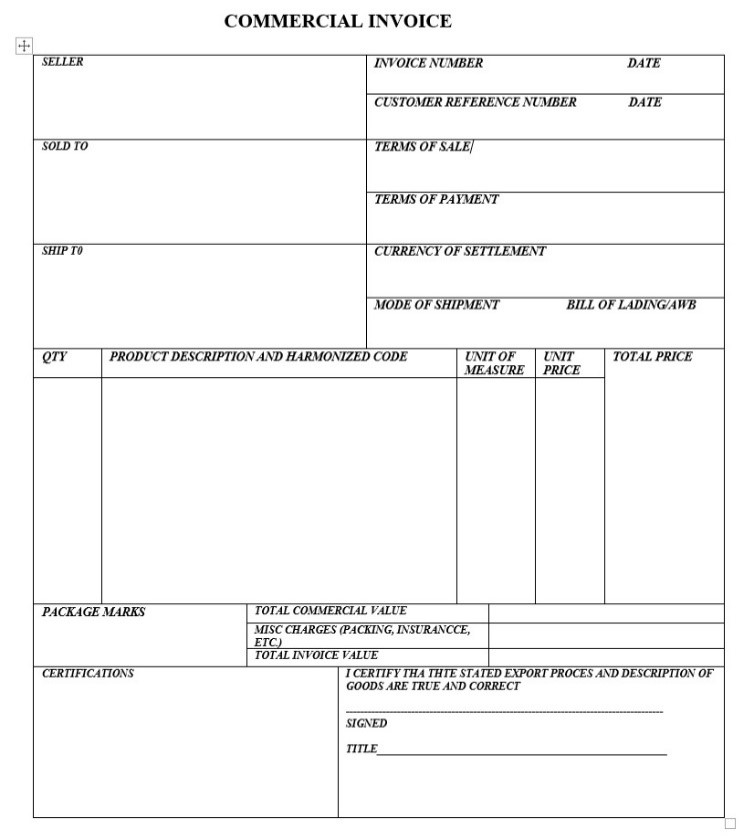
EORI Number
Both imported and exported goods that come through UK customs are tracked with an EORI number. All business within the UK importing commercial cargo from China are required to have an EORI. This is required with a commercial invoice if you’re submitting an electronic export declaration and using the CHIEF system.
Shipments made through a courier or freight forwarder also require an EORI number. It is easy to apply for an EORI number. Simply submit an online application and you will receive it in approximately three days.
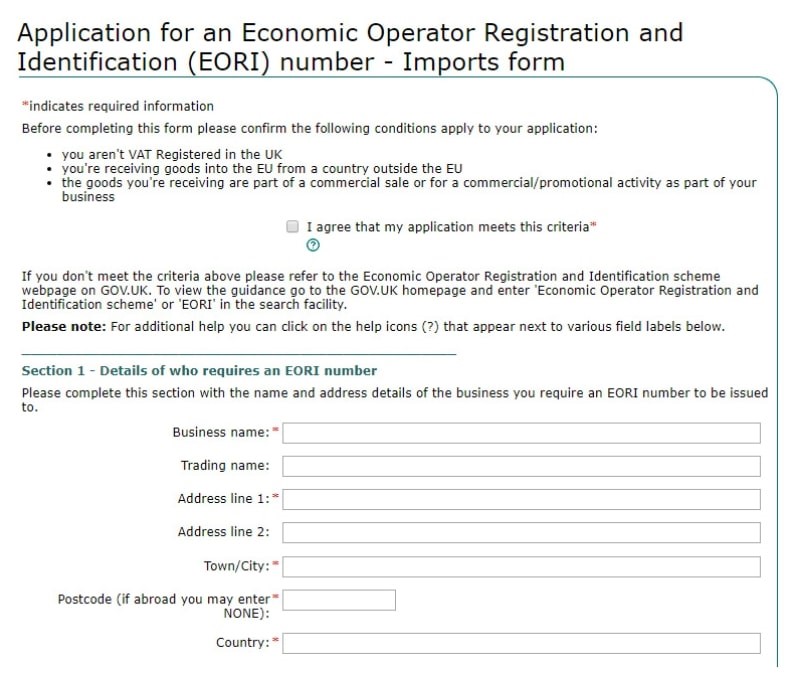
The EORI number will be allocated through HMRC in the UK for the sake of customs clearance and custom access declaration.
The customs authorities grant EORI numbers to be used exclusively by a company for indefinite duration.
It is mandatory to have an EORI number because it enables you to avoid inconveniences that arise from deliberate possession of the consignment.
UK Import License
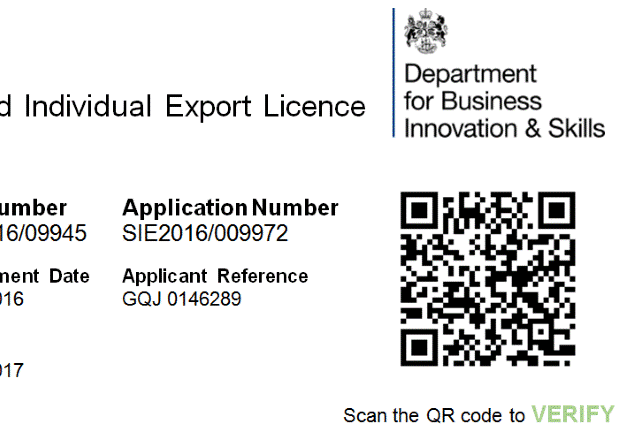
You must ensure that you obtain an import license before you try to import from China to UK, especially if they are in the surveillance control category. Visit the Department for International Trade’s website if you want to find out how to obtain an import license.
Some goods are also subject to import controls. Make sure to check if any of these three types of import controls apply to the goods that you need to ship:
- Bans – No import is allowed
- Surveillance – Ensures that the importation is monitored using licenses
- Quotas – A restriction in the volume of goods
Depending on the type of product that you’re importing from China to UK, this document comes in various forms. It’s not necessarily vital when importing industrial goods into the UK to have an import license. Nevertheless, it is still important to have one as an importer because it enables you to make your importing activities easier.
Agricultural products, chemicals, and pharmaceuticals are categories that require you to have a UK import license. Also, plants and live animals and many medical products also require you to have a special import license.
Bill of lading
This document is a negotiable multi-modal document that the shipping line issues for transporting the product. It certifies the carriage of the cargo as stated in the specific invoice on behalf of the importer. This depends on the terms of sale. Put another way, this is the document that the agent or carrier issues to acknowledge your shipment and cargo.
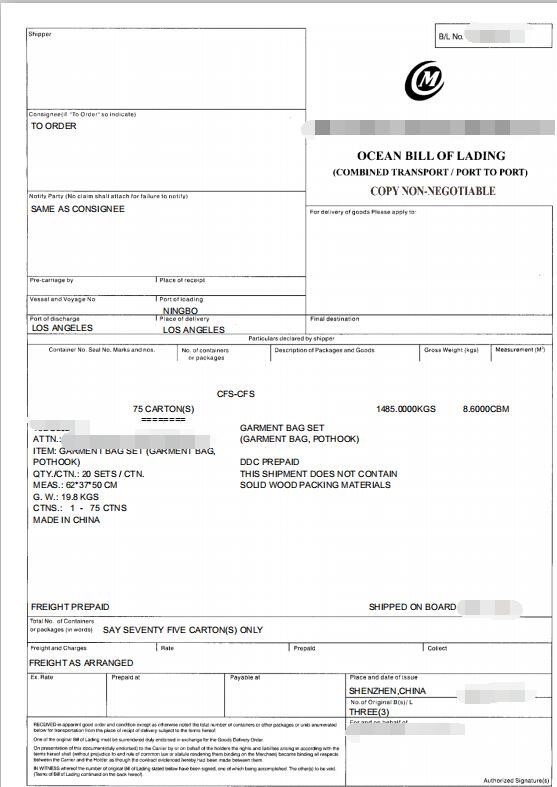
It serves three primary functions:
– It shows the conditions and terms as well as the contract between the carrier and the importer.
– It serves as a document of title to the goods of course subject to the Nemodat rule.
– It provides a conclusive receipt acknowledging that the goods were loaded.
When purchasing from China to the UK, these are the main documents that you must produce. Of course, there are some additional ones that you’ll have to submit as a way of facilitating record keeping of the process or just as a formality.
There are also other necessary elements in the import process besides the importing documents. Keep the following highlights in mind:
CR Number and Power of Attorney (POA)
You must have a Customs Registration number (also known as a CR number) when importing or exporting goods from China to UK.
This number is necessary during the customs clearing process and is often indicated on the commercial customs invoice. It verifies that you’re a legal importer and authorized to carry out the business you’re in. It makes sure that importing your product from China is a seamless process.
Certificate of origin

A certificate of origin is the way of determining the classification of the imported cargo under a specific schedule in the UK. This is an essential document that gives the customs the ability to prevent imports from third-party countries. It also improves license restriction and efficiency in collecting duty and tax.
.
CHIEF
It is important to understand that the UK has a way to handle all of its imports using current systems for import documentation. The system is known as customs handling of import and Export Freight (CHIEF).
It is a system which records the declaration to customs of cargo by sea, land or air. This system generally enables you as a freight forwarder, exporter, or importer to electronically fill customs details. It is able to check for and detect possible entry errors.
Essentially, CHIEF is a national UK computerized system that helps the government to collect revenue.
It also protects society through regulation of the import of restrict goods, and helps the government collect accurate statistics regarding international trade.
Commodity code
It is an integral part of the UK importation business to know use the commodity code. It enables you to fill out all declarations and other necessary paperwork. It is also necessary as it allows you to confirm whether there’s VAT or duty that must be paid. It also gives you more clarity about duty reliefs.
Packing list
This document gives information regarding the parcels in the consignment. It provides an overview of the shipping marks, the net weight of each parcel, the number of units in each parcel, as well as the dimension of each parcel.
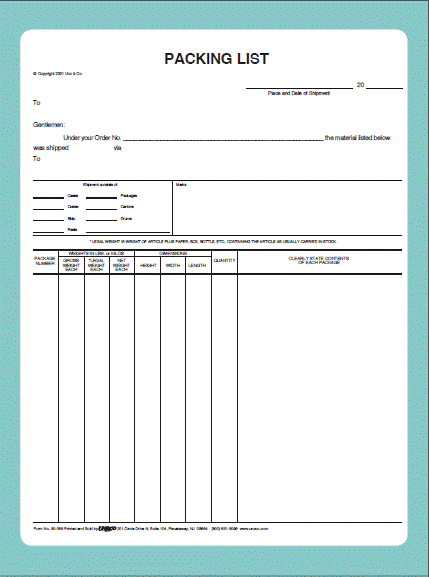
It is important to realize that it’s mandatory to place the shipping marks on all the cargo that is covering each piece.
Essentially, all this documentation makes it possible for you to determine the wise moves to make for your business as well as removing from unwarranted inconveniences. You probably already know chaotic the importation business can be if there are no specific rules.
For the interest of your sanity in carrying out this business, make sure you have your documents in order. Moreover, documentation also helps create a useful database helpful in determining practical matters of business.
Quality Compliance Standards on imports from China to UK
You must have a strong understanding of quality standards if you want to import from China to UK. The UK market, in general, never compromises quality standards. As an importer, you must take into consideration that UK authorities keep superior standards in high regard.
There is high risk involved with knowingly importing products which are inferior in quality, ranging from health hazards to environmental degradation. Therefore, the UK government sets quality standard procedures to make sure they meet expectations. These procedures are well-established through a government body mandated to handle all import quality assurance.
The importer is tasked by this agency in ensuring that their imported goods conform to the standards. You must also sign and keep a copy of the declaration of conformity for your particular product. These expectations serve to ensure that poor-quality products have a hard time entering the UK market. Low-quality products from low-quality Chinese suppliers could be seized, destroyed, or returned. Ultimately, this greatly benefits UK residents and the environment.
Conclusion
Here at HUACI Sourcing, we hope this guide has strengthened your understanding of how to import from China to UK. If you have a firm foundation of understanding all the pieces of the puzzle, the process will not be too difficult. We are always here to assist you in taking your Chinese import business to the next level. Reach out to us today to get started!


Great guide! thank you for explaining step by step how to import from China.
would like to ship from China to uk 1.4 kg 33x23x13cm branded shoes, clothing… would like to know time frame and price.
Why do big companies produce in China?
There are several advantages that China provides as one of the benchmark production locations. On the one hand, the attitude of the Chinese, they are enthusiastic when it comes to doing business and, in general, they do a good job. They have the necessary infrastructure, so there is no need to recreate it from scratch. In addition, shipping costs are often affordable.
If I want to import from China what should I know?
The types of tariffs that are required according to the country you live in and/or look for the way to do it through an expert so that you can see according to the product you want to import, the regulations and taxes you will face, also check the INCOTERMS.
What do I need to be aware of so that my products are not banned if I import them from China to the UK?
First of all check which of your goods are subject to import controls. You must take into account checking if any apply to the goods you need to import. There are three types of controls you need to know: Bans, no import is allowed. Quotas, the volume of goods is restricted. Surveillance, the import of goods is monitored with licences. If your goods needs surveillance control, make sure you obtain a licence before trying to import your goods from China.
Among the available payment options, which one should I choose?
This will depend on the business you have, but also on the supplier. It is always highly recommended to select the 0% deposit, 100% against bill of lading option or the 0% deposit 100% balance after 90 days. Although 0% deposit is ideal, in most cases, the minimum deposit is 30%.
Always try to agree with them on a reasonable deal for both parties, seeking the fairest deal, thus creating a relationship of respect between both commercial parties.
Why should I import from China and not from another country?
Importing from China offers great opportunities and advantages. The main ones are:
Flexibility: Manufacturers in China set lower minimum order requirements for mass production, have greater expertise with tooling and molding, and can produce in larger volumes.
Price: Savings from buying from a Chinese manufacturer range from 30% to 150% for most products compared to manufacturing in the West.
Competitive advantage: Developed infrastructure, established raw material supply chains, skilled workforce, are some of the advantages that this country offers.
What are the cons of direct importing from China?
The cons that should be considered before importing from China are: few factories have a good knowledge of how to fully meet and solve customers’ needs and pain points, some of the factories might not have an actual export license or real experience, you must invest a large amount of effort and time to deal with the whole import process and supply chain management and the import process can be slow.
What taxes do I have to pay when importing from China to the UK?
When paying taxes on your imports from China to UK, there are some considerations that you must take into account:
You pay VAT on everything it costs you to buy the goods in China and move them around the UK.
The dutiable import on which VAT is payable is the amount you pay for the goods, plus shipping costs, plus UK customs duty.
If you buy goods from China, you will not pay VAT to the supplier, but that does not mean you do not have to pay VAT at all.
What are the considerations that I should take into account before importing from China?
When importing from China to the UK, it is crucial to have a clear idea of what your considerations should be prior to import. These considerations are:
Commercial Invoice: Gives a description of the products, verifies the sale, and reflects the consignment price.
UK Import Licence: Obtain an import licence before you try to import from China to UK
Bill of lading: Document issued by the shipping company for the transport of the product. It certifies the transport of the cargo as indicated on the specific invoice on behalf of the importer.
EORI Number: Both imported and exported goods passing through UK customs are tracked with an EORI number.
Certificate of origin: The way to determine the classification of imported cargo on a specific list in the UK.
CR Number: You must have a Customs Registration number when importing or exporting goods from China to the UK
Commodity code: It allows you to complete all the necessary declarations and other paperwork.
CHIEF: A system that records the customs declaration of cargo by sea, land or air. This system generally allows you, as a freight forwarder, exporter or importer, to electronically fill in customs data. It is able to check and detect possible entry errors.
Packing list: Provides information about the packages in the shipment.
Are there some tips when it comes to select a product to import from China to UK?
Yes, there are a few top tips when it comes to importing successfully from China to the UK. These tips are:
Have at least one unique selling point: If you import products from China to UK, and want to be different from your competition, a unique selling point is key.
Don’t overlook product safety: When importing products from China into the UK, it is essential to ensure that the products are not risky.
Stay away from trendy products: Trendy products normally have a brief lifetime, that is why t is important to stay away from them when importing products from China to UK.
Building a brand around a product is one of the best things you can do: Crucial to connect and engage with people.
Is there a way to calculate landed cost when importing from China to UK?
Although it is difficult to make an accurate estimate of the landed cost when importing from China to UK, it is important to have an estimation and not to skip this step. In order to calculate the cost, the necessary data are:
Port of loading, product pricing and details, total cubic meters of order, overall packaging size, currency of quote, and type of shipment of your imports from China to UK
Local charges at the country of import, freight costs from port of loading to port of discharge, trucking costs, local taxes, and local duty rates.
Exchange rate and currency costs
By having this information available, the forecast made of your landed cost when importing from China to the UK will be very accurate.
When it comes to import from China to the UK, is it better to use Alibaba or Made in China?
When importing from China to the UK, you will always want to look for the right supplier, so that your product has the best quality. When comparing Alibaba and Made in China, we have to consider that they have different use cases. On the one hand, Alibaba is the right place for every product. You will find whatever you need. On the other hand, Made in China focused only on industrial and construction products. In addition, on both platforms, you will have to order a minimum quantity.
During the purchasing phase when importing from China to the UK, what should I take into account?
There is a crucial thing that you must take into account when importing from China to the UK, which is to sign a contract that contains clear information about the agreement with your supplier in China. A clear purchase agreement must be in place for any product imported from China to the UK.